Impact of Technology on Marketing Research in Today’s Business
VerifiedAdded on 2023/06/04
|9
|2142
|382
Report
AI Summary
This report examines the impact of technology, particularly social media and the internet, on modern marketing research. It highlights the shift from traditional methods to leveraging online surveys, social media analytics, and vast online data resources for gaining competitive advantage. The research emphasizes the benefits of social media analytics in understanding customer sentiments, market trends, and optimizing marketing strategies. It concludes that social media marketing is a powerful tool for businesses to reach objectives, analyze market demands, and identify potential customers, ultimately leading to cost reduction and enhanced reach. The report suggests that businesses should adopt this new technology to stay competitive and provide clear information to customers.
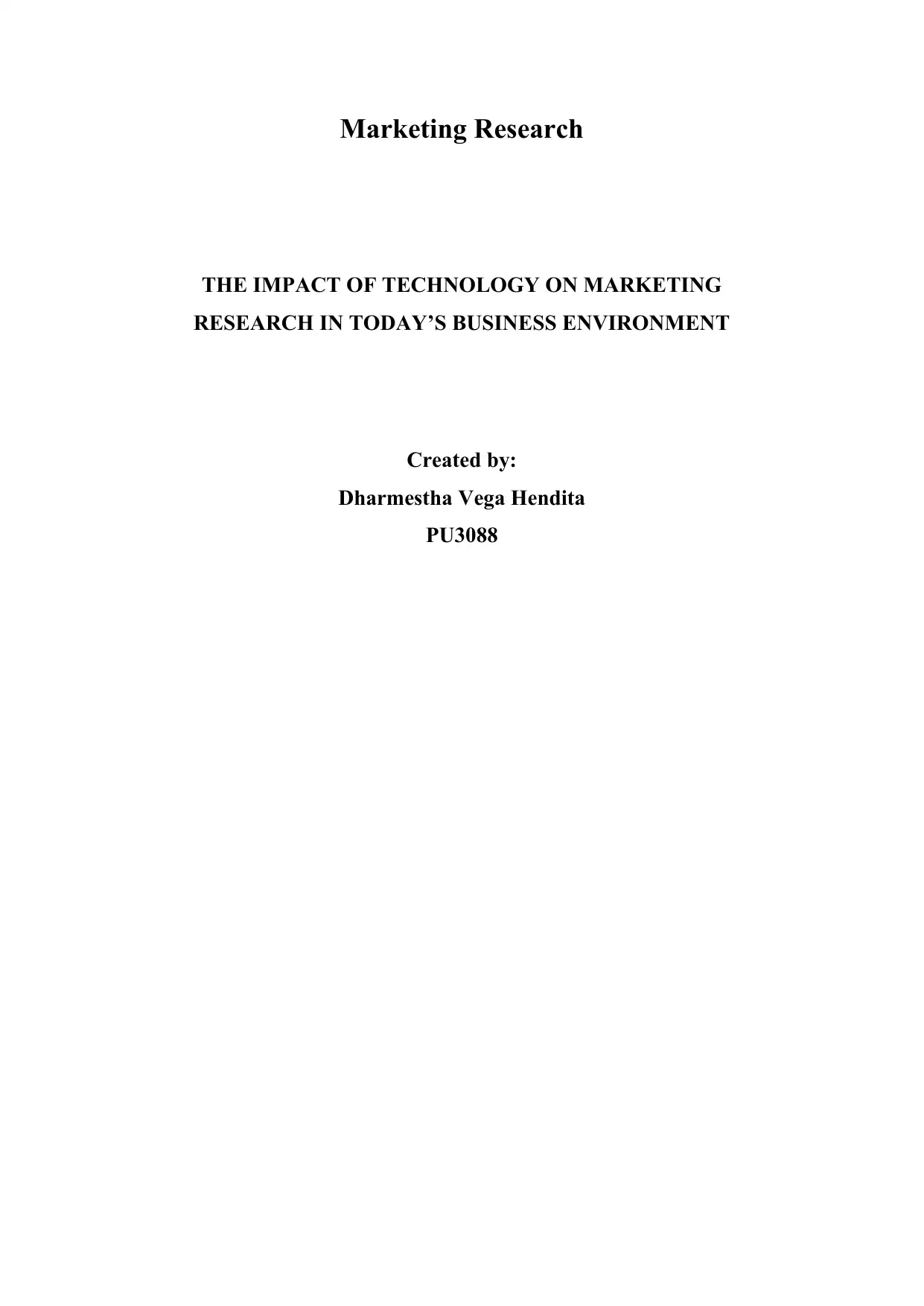
Marketing Research
THE IMPACT OF TECHNOLOGY ON MARKETING
RESEARCH IN TODAY’S BUSINESS ENVIRONMENT
Created by:
Dharmestha Vega Hendita
PU3088
THE IMPACT OF TECHNOLOGY ON MARKETING
RESEARCH IN TODAY’S BUSINESS ENVIRONMENT
Created by:
Dharmestha Vega Hendita
PU3088
Paraphrase This Document
Need a fresh take? Get an instant paraphrase of this document with our AI Paraphraser
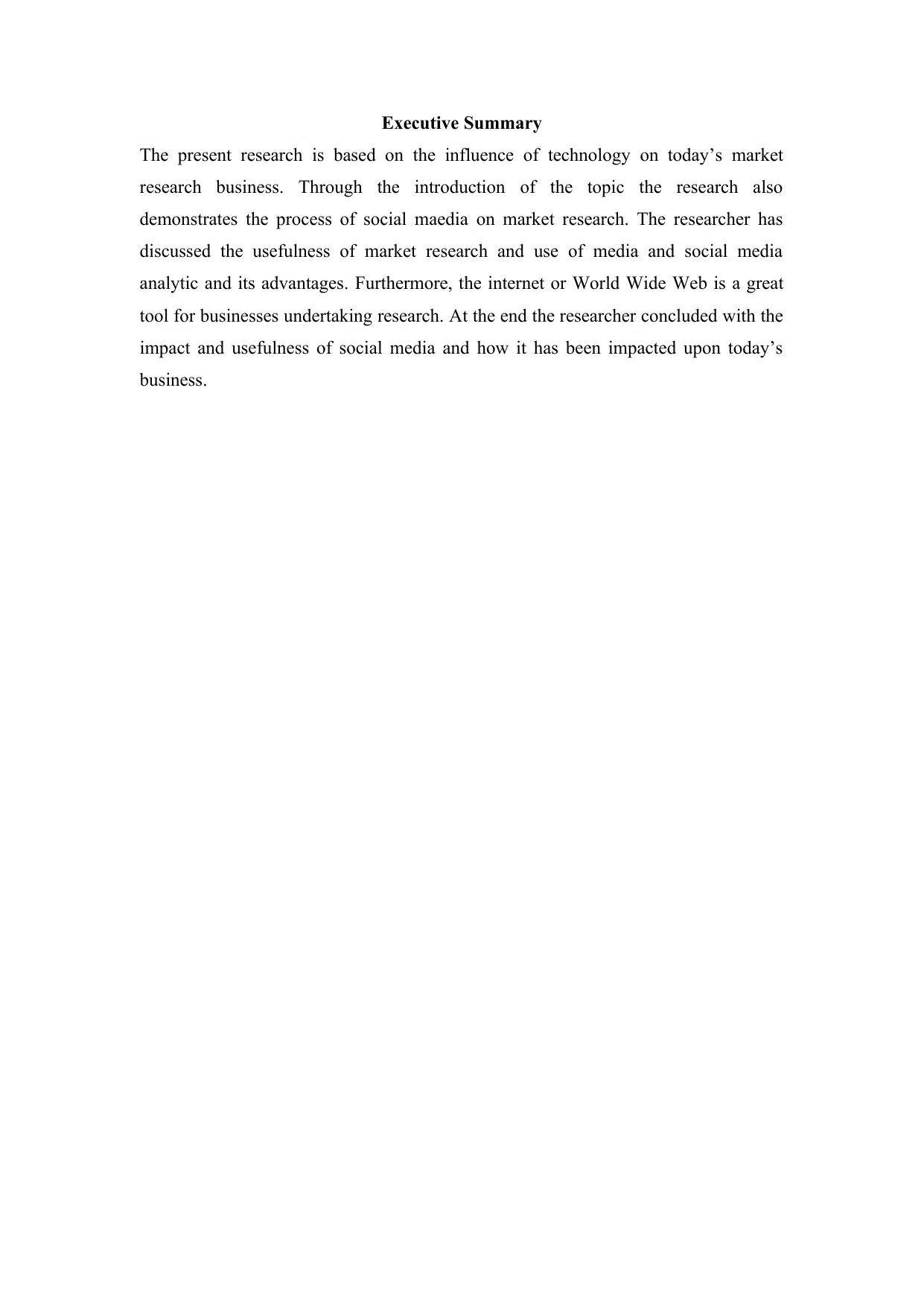
Executive Summary
The present research is based on the influence of technology on today’s market
research business. Through the introduction of the topic the research also
demonstrates the process of social maedia on market research. The researcher has
discussed the usefulness of market research and use of media and social media
analytic and its advantages. Furthermore, the internet or World Wide Web is a great
tool for businesses undertaking research. At the end the researcher concluded with the
impact and usefulness of social media and how it has been impacted upon today’s
business.
The present research is based on the influence of technology on today’s market
research business. Through the introduction of the topic the research also
demonstrates the process of social maedia on market research. The researcher has
discussed the usefulness of market research and use of media and social media
analytic and its advantages. Furthermore, the internet or World Wide Web is a great
tool for businesses undertaking research. At the end the researcher concluded with the
impact and usefulness of social media and how it has been impacted upon today’s
business.
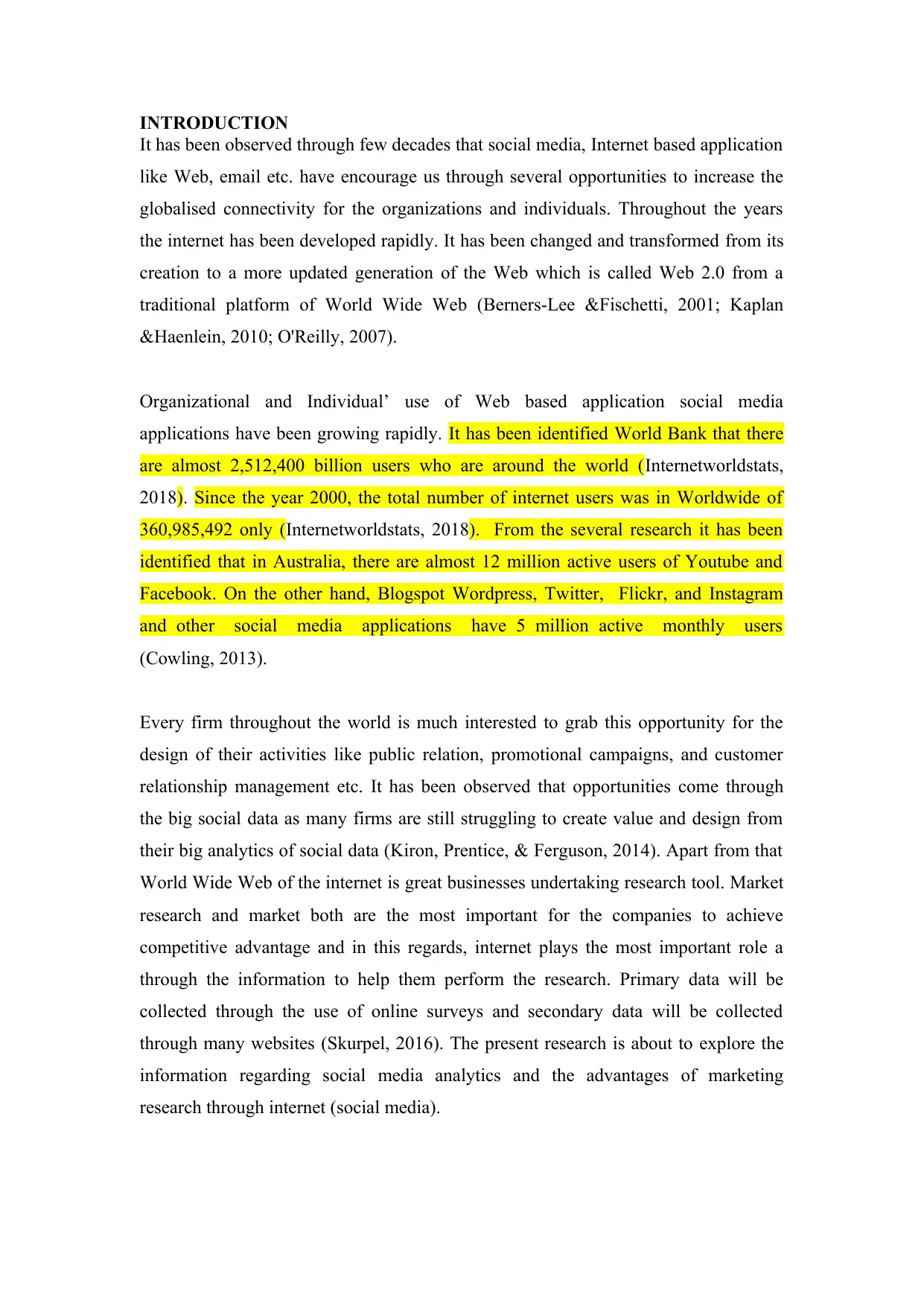
INTRODUCTION
It has been observed through few decades that social media, Internet based application
like Web, email etc. have encourage us through several opportunities to increase the
globalised connectivity for the organizations and individuals. Throughout the years
the internet has been developed rapidly. It has been changed and transformed from its
creation to a more updated generation of the Web which is called Web 2.0 from a
traditional platform of World Wide Web (Berners-Lee &Fischetti, 2001; Kaplan
&Haenlein, 2010; O'Reilly, 2007).
Organizational and Individual’ use of Web based application social media
applications have been growing rapidly. It has been identified World Bank that there
are almost 2,512,400 billion users who are around the world (Internetworldstats,
2018). Since the year 2000, the total number of internet users was in Worldwide of
360,985,492 only (Internetworldstats, 2018). From the several research it has been
identified that in Australia, there are almost 12 million active users of Youtube and
Facebook. On the other hand, Blogspot Wordpress, Twitter, Flickr, and Instagram
and other social media applications have 5 million active monthly users
(Cowling, 2013).
Every firm throughout the world is much interested to grab this opportunity for the
design of their activities like public relation, promotional campaigns, and customer
relationship management etc. It has been observed that opportunities come through
the big social data as many firms are still struggling to create value and design from
their big analytics of social data (Kiron, Prentice, & Ferguson, 2014). Apart from that
World Wide Web of the internet is great businesses undertaking research tool. Market
research and market both are the most important for the companies to achieve
competitive advantage and in this regards, internet plays the most important role a
through the information to help them perform the research. Primary data will be
collected through the use of online surveys and secondary data will be collected
through many websites (Skurpel, 2016). The present research is about to explore the
information regarding social media analytics and the advantages of marketing
research through internet (social media).
It has been observed through few decades that social media, Internet based application
like Web, email etc. have encourage us through several opportunities to increase the
globalised connectivity for the organizations and individuals. Throughout the years
the internet has been developed rapidly. It has been changed and transformed from its
creation to a more updated generation of the Web which is called Web 2.0 from a
traditional platform of World Wide Web (Berners-Lee &Fischetti, 2001; Kaplan
&Haenlein, 2010; O'Reilly, 2007).
Organizational and Individual’ use of Web based application social media
applications have been growing rapidly. It has been identified World Bank that there
are almost 2,512,400 billion users who are around the world (Internetworldstats,
2018). Since the year 2000, the total number of internet users was in Worldwide of
360,985,492 only (Internetworldstats, 2018). From the several research it has been
identified that in Australia, there are almost 12 million active users of Youtube and
Facebook. On the other hand, Blogspot Wordpress, Twitter, Flickr, and Instagram
and other social media applications have 5 million active monthly users
(Cowling, 2013).
Every firm throughout the world is much interested to grab this opportunity for the
design of their activities like public relation, promotional campaigns, and customer
relationship management etc. It has been observed that opportunities come through
the big social data as many firms are still struggling to create value and design from
their big analytics of social data (Kiron, Prentice, & Ferguson, 2014). Apart from that
World Wide Web of the internet is great businesses undertaking research tool. Market
research and market both are the most important for the companies to achieve
competitive advantage and in this regards, internet plays the most important role a
through the information to help them perform the research. Primary data will be
collected through the use of online surveys and secondary data will be collected
through many websites (Skurpel, 2016). The present research is about to explore the
information regarding social media analytics and the advantages of marketing
research through internet (social media).
⊘ This is a preview!⊘
Do you want full access?
Subscribe today to unlock all pages.

Trusted by 1+ million students worldwide
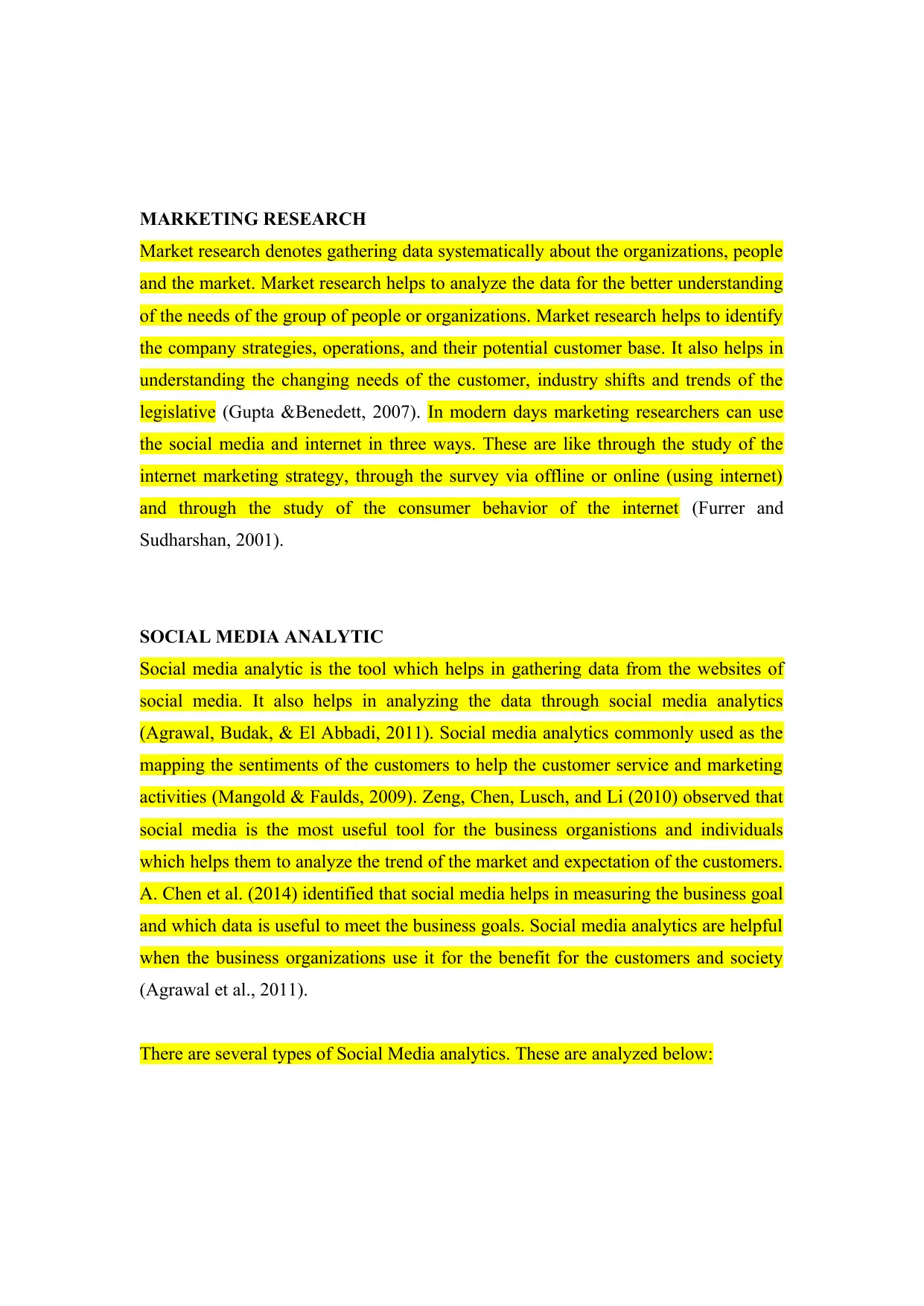
MARKETING RESEARCH
Market research denotes gathering data systematically about the organizations, people
and the market. Market research helps to analyze the data for the better understanding
of the needs of the group of people or organizations. Market research helps to identify
the company strategies, operations, and their potential customer base. It also helps in
understanding the changing needs of the customer, industry shifts and trends of the
legislative (Gupta &Benedett, 2007). In modern days marketing researchers can use
the social media and internet in three ways. These are like through the study of the
internet marketing strategy, through the survey via offline or online (using internet)
and through the study of the consumer behavior of the internet (Furrer and
Sudharshan, 2001).
SOCIAL MEDIA ANALYTIC
Social media analytic is the tool which helps in gathering data from the websites of
social media. It also helps in analyzing the data through social media analytics
(Agrawal, Budak, & El Abbadi, 2011). Social media analytics commonly used as the
mapping the sentiments of the customers to help the customer service and marketing
activities (Mangold & Faulds, 2009). Zeng, Chen, Lusch, and Li (2010) observed that
social media is the most useful tool for the business organistions and individuals
which helps them to analyze the trend of the market and expectation of the customers.
A. Chen et al. (2014) identified that social media helps in measuring the business goal
and which data is useful to meet the business goals. Social media analytics are helpful
when the business organizations use it for the benefit for the customers and society
(Agrawal et al., 2011).
There are several types of Social Media analytics. These are analyzed below:
Market research denotes gathering data systematically about the organizations, people
and the market. Market research helps to analyze the data for the better understanding
of the needs of the group of people or organizations. Market research helps to identify
the company strategies, operations, and their potential customer base. It also helps in
understanding the changing needs of the customer, industry shifts and trends of the
legislative (Gupta &Benedett, 2007). In modern days marketing researchers can use
the social media and internet in three ways. These are like through the study of the
internet marketing strategy, through the survey via offline or online (using internet)
and through the study of the consumer behavior of the internet (Furrer and
Sudharshan, 2001).
SOCIAL MEDIA ANALYTIC
Social media analytic is the tool which helps in gathering data from the websites of
social media. It also helps in analyzing the data through social media analytics
(Agrawal, Budak, & El Abbadi, 2011). Social media analytics commonly used as the
mapping the sentiments of the customers to help the customer service and marketing
activities (Mangold & Faulds, 2009). Zeng, Chen, Lusch, and Li (2010) observed that
social media is the most useful tool for the business organistions and individuals
which helps them to analyze the trend of the market and expectation of the customers.
A. Chen et al. (2014) identified that social media helps in measuring the business goal
and which data is useful to meet the business goals. Social media analytics are helpful
when the business organizations use it for the benefit for the customers and society
(Agrawal et al., 2011).
There are several types of Social Media analytics. These are analyzed below:
Paraphrase This Document
Need a fresh take? Get an instant paraphrase of this document with our AI Paraphraser
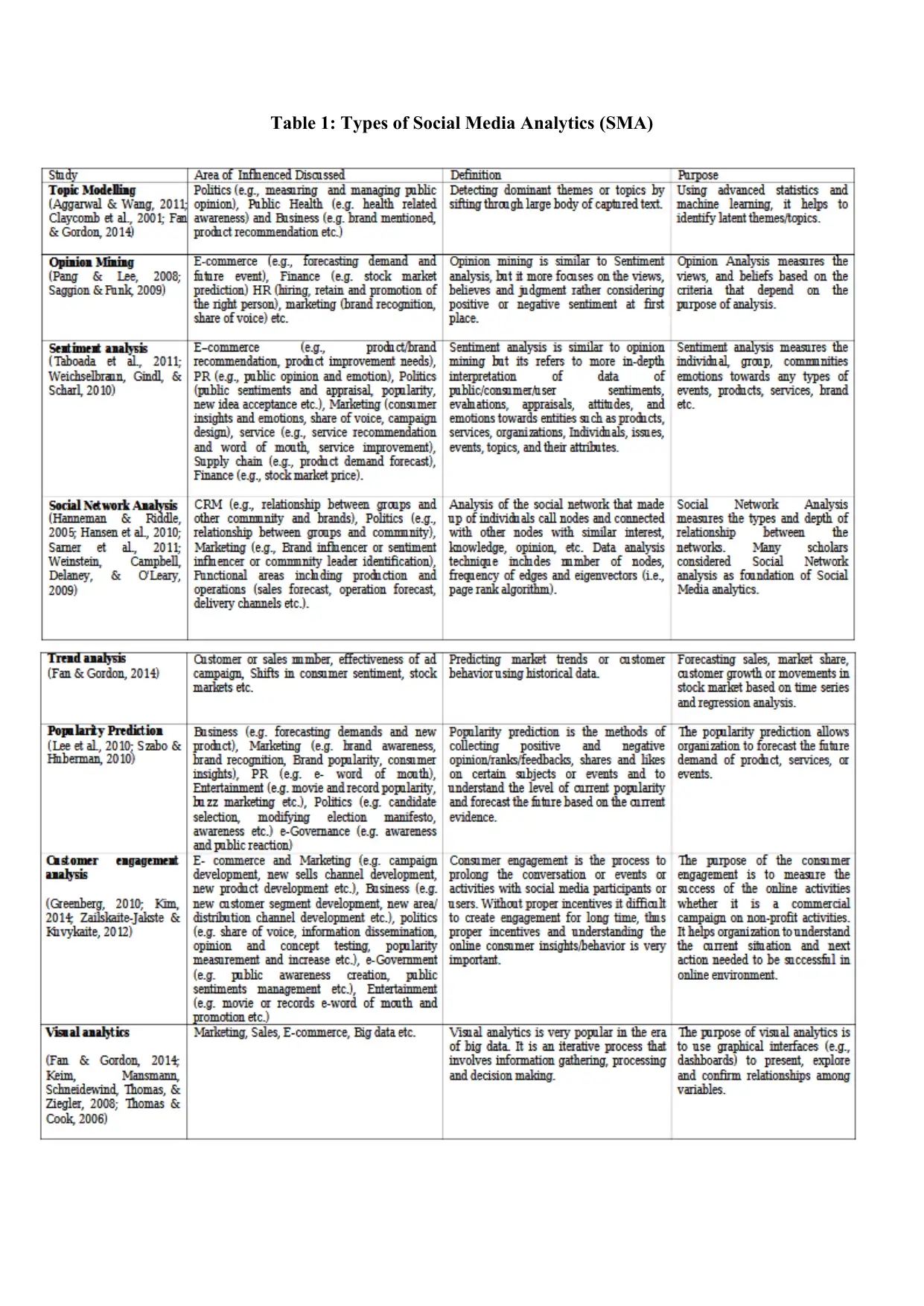
Table 1: Types of Social Media Analytics (SMA)
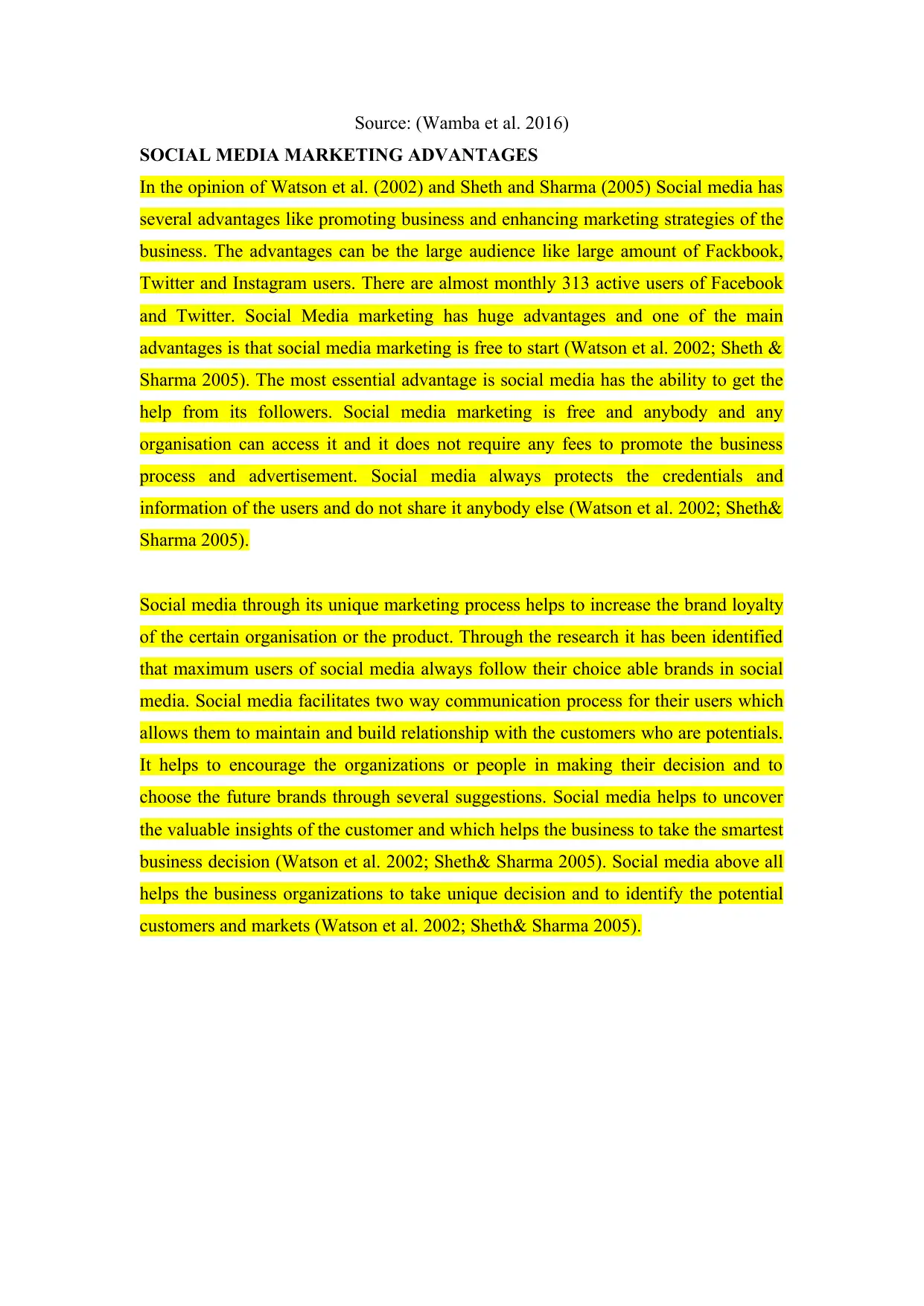
Source: (Wamba et al. 2016)
SOCIAL MEDIA MARKETING ADVANTAGES
In the opinion of Watson et al. (2002) and Sheth and Sharma (2005) Social media has
several advantages like promoting business and enhancing marketing strategies of the
business. The advantages can be the large audience like large amount of Fackbook,
Twitter and Instagram users. There are almost monthly 313 active users of Facebook
and Twitter. Social Media marketing has huge advantages and one of the main
advantages is that social media marketing is free to start (Watson et al. 2002; Sheth &
Sharma 2005). The most essential advantage is social media has the ability to get the
help from its followers. Social media marketing is free and anybody and any
organisation can access it and it does not require any fees to promote the business
process and advertisement. Social media always protects the credentials and
information of the users and do not share it anybody else (Watson et al. 2002; Sheth&
Sharma 2005).
Social media through its unique marketing process helps to increase the brand loyalty
of the certain organisation or the product. Through the research it has been identified
that maximum users of social media always follow their choice able brands in social
media. Social media facilitates two way communication process for their users which
allows them to maintain and build relationship with the customers who are potentials.
It helps to encourage the organizations or people in making their decision and to
choose the future brands through several suggestions. Social media helps to uncover
the valuable insights of the customer and which helps the business to take the smartest
business decision (Watson et al. 2002; Sheth& Sharma 2005). Social media above all
helps the business organizations to take unique decision and to identify the potential
customers and markets (Watson et al. 2002; Sheth& Sharma 2005).
SOCIAL MEDIA MARKETING ADVANTAGES
In the opinion of Watson et al. (2002) and Sheth and Sharma (2005) Social media has
several advantages like promoting business and enhancing marketing strategies of the
business. The advantages can be the large audience like large amount of Fackbook,
Twitter and Instagram users. There are almost monthly 313 active users of Facebook
and Twitter. Social Media marketing has huge advantages and one of the main
advantages is that social media marketing is free to start (Watson et al. 2002; Sheth &
Sharma 2005). The most essential advantage is social media has the ability to get the
help from its followers. Social media marketing is free and anybody and any
organisation can access it and it does not require any fees to promote the business
process and advertisement. Social media always protects the credentials and
information of the users and do not share it anybody else (Watson et al. 2002; Sheth&
Sharma 2005).
Social media through its unique marketing process helps to increase the brand loyalty
of the certain organisation or the product. Through the research it has been identified
that maximum users of social media always follow their choice able brands in social
media. Social media facilitates two way communication process for their users which
allows them to maintain and build relationship with the customers who are potentials.
It helps to encourage the organizations or people in making their decision and to
choose the future brands through several suggestions. Social media helps to uncover
the valuable insights of the customer and which helps the business to take the smartest
business decision (Watson et al. 2002; Sheth& Sharma 2005). Social media above all
helps the business organizations to take unique decision and to identify the potential
customers and markets (Watson et al. 2002; Sheth& Sharma 2005).
⊘ This is a preview!⊘
Do you want full access?
Subscribe today to unlock all pages.

Trusted by 1+ million students worldwide
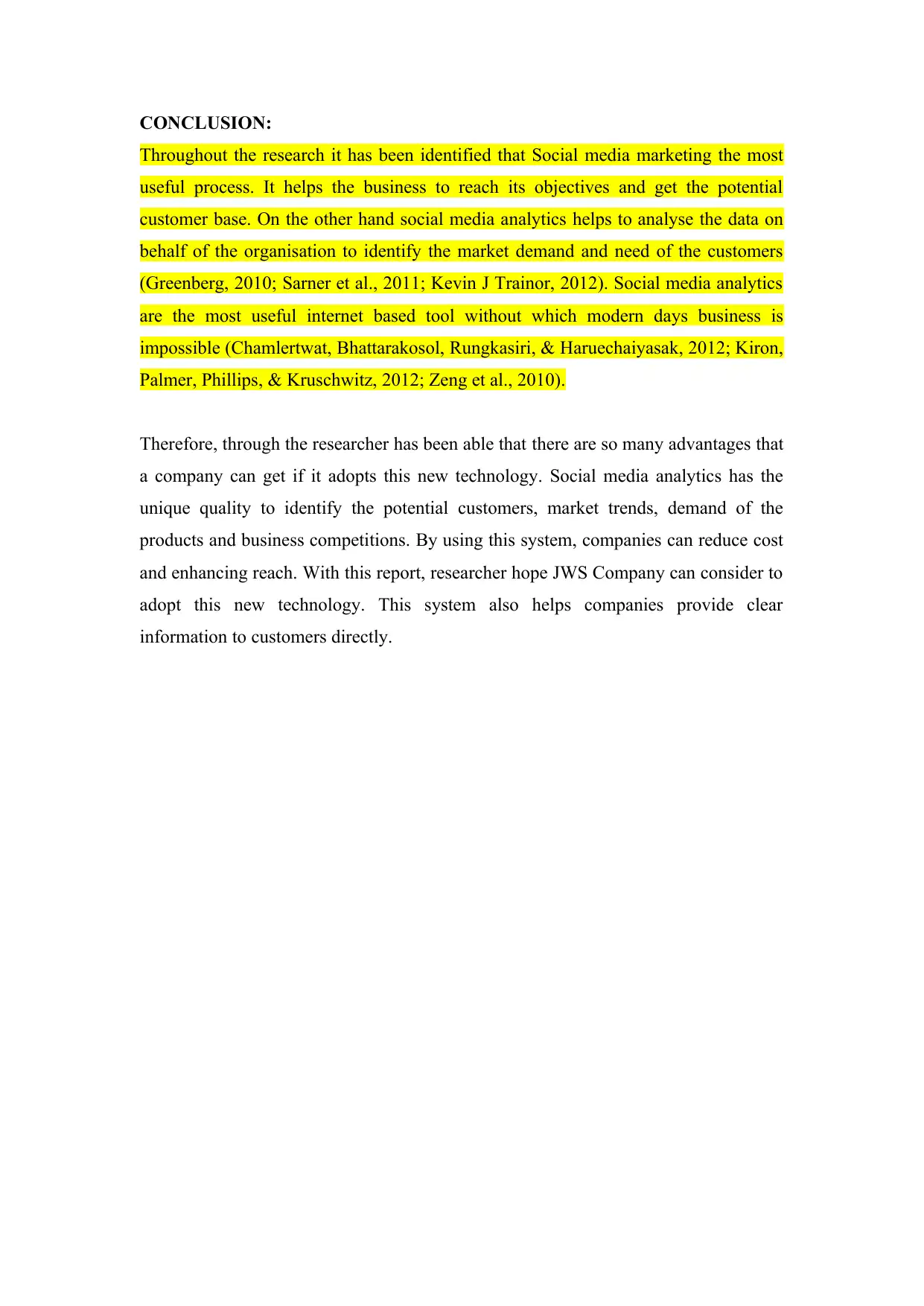
CONCLUSION:
Throughout the research it has been identified that Social media marketing the most
useful process. It helps the business to reach its objectives and get the potential
customer base. On the other hand social media analytics helps to analyse the data on
behalf of the organisation to identify the market demand and need of the customers
(Greenberg, 2010; Sarner et al., 2011; Kevin J Trainor, 2012). Social media analytics
are the most useful internet based tool without which modern days business is
impossible (Chamlertwat, Bhattarakosol, Rungkasiri, & Haruechaiyasak, 2012; Kiron,
Palmer, Phillips, & Kruschwitz, 2012; Zeng et al., 2010).
Therefore, through the researcher has been able that there are so many advantages that
a company can get if it adopts this new technology. Social media analytics has the
unique quality to identify the potential customers, market trends, demand of the
products and business competitions. By using this system, companies can reduce cost
and enhancing reach. With this report, researcher hope JWS Company can consider to
adopt this new technology. This system also helps companies provide clear
information to customers directly.
Throughout the research it has been identified that Social media marketing the most
useful process. It helps the business to reach its objectives and get the potential
customer base. On the other hand social media analytics helps to analyse the data on
behalf of the organisation to identify the market demand and need of the customers
(Greenberg, 2010; Sarner et al., 2011; Kevin J Trainor, 2012). Social media analytics
are the most useful internet based tool without which modern days business is
impossible (Chamlertwat, Bhattarakosol, Rungkasiri, & Haruechaiyasak, 2012; Kiron,
Palmer, Phillips, & Kruschwitz, 2012; Zeng et al., 2010).
Therefore, through the researcher has been able that there are so many advantages that
a company can get if it adopts this new technology. Social media analytics has the
unique quality to identify the potential customers, market trends, demand of the
products and business competitions. By using this system, companies can reduce cost
and enhancing reach. With this report, researcher hope JWS Company can consider to
adopt this new technology. This system also helps companies provide clear
information to customers directly.
Paraphrase This Document
Need a fresh take? Get an instant paraphrase of this document with our AI Paraphraser
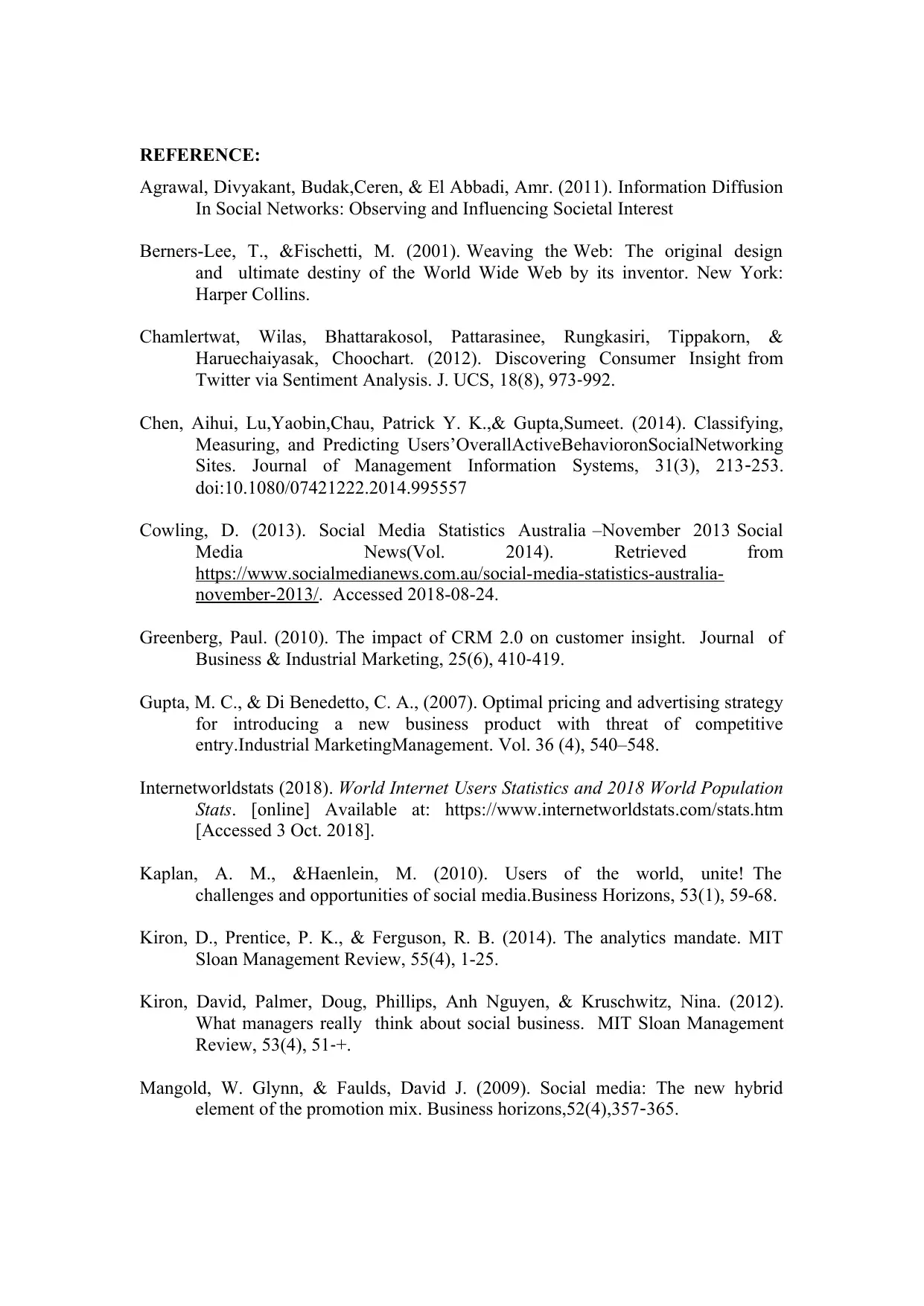
REFERENCE:
Agrawal, Divyakant, Budak,Ceren, & El Abbadi, Amr. (2011). Information Diffusion
In Social Networks: Observing and Influencing Societal Interest
Berners-Lee, T., &Fischetti, M. (2001). Weaving the Web: The original design
and ultimate destiny of the World Wide Web by its inventor. New York:
Harper Collins.
Chamlertwat, Wilas, Bhattarakosol, Pattarasinee, Rungkasiri, Tippakorn, &
Haruechaiyasak, Choochart. (2012). Discovering Consumer Insight from
Twitter via Sentiment Analysis. J. UCS, 18(8), 973‐992.
Chen, Aihui, Lu,Yaobin,Chau, Patrick Y. K.,& Gupta,Sumeet. (2014). Classifying,
Measuring, and Predicting Users’OverallActiveBehavioronSocialNetworking
Sites. Journal of Management Information Systems, 31(3), 213‐253.
doi:10.1080/07421222.2014.995557
Cowling, D. (2013). Social Media Statistics Australia –November 2013 Social
Media News(Vol. 2014). Retrieved from
https://www.socialmedianews.com.au/social-media-statistics-australia-
november-2013/. Accessed 2018-08-24.
Greenberg, Paul. (2010). The impact of CRM 2.0 on customer insight. Journal of
Business & Industrial Marketing, 25(6), 410‐419.
Gupta, M. C., & Di Benedetto, C. A., (2007). Optimal pricing and advertising strategy
for introducing a new business product with threat of competitive
entry.Industrial MarketingManagement. Vol. 36 (4), 540–548.
Internetworldstats (2018). World Internet Users Statistics and 2018 World Population
Stats. [online] Available at: https://www.internetworldstats.com/stats.htm
[Accessed 3 Oct. 2018].
Kaplan, A. M., &Haenlein, M. (2010). Users of the world, unite! The
challenges and opportunities of social media.Business Horizons, 53(1), 59-68.
Kiron, D., Prentice, P. K., & Ferguson, R. B. (2014). The analytics mandate. MIT
Sloan Management Review, 55(4), 1-25.
Kiron, David, Palmer, Doug, Phillips, Anh Nguyen, & Kruschwitz, Nina. (2012).
What managers really think about social business. MIT Sloan Management
Review, 53(4), 51‐+.
Mangold, W. Glynn, & Faulds, David J. (2009). Social media: The new hybrid
element of the promotion mix. Business horizons,52(4),357‐365.
Agrawal, Divyakant, Budak,Ceren, & El Abbadi, Amr. (2011). Information Diffusion
In Social Networks: Observing and Influencing Societal Interest
Berners-Lee, T., &Fischetti, M. (2001). Weaving the Web: The original design
and ultimate destiny of the World Wide Web by its inventor. New York:
Harper Collins.
Chamlertwat, Wilas, Bhattarakosol, Pattarasinee, Rungkasiri, Tippakorn, &
Haruechaiyasak, Choochart. (2012). Discovering Consumer Insight from
Twitter via Sentiment Analysis. J. UCS, 18(8), 973‐992.
Chen, Aihui, Lu,Yaobin,Chau, Patrick Y. K.,& Gupta,Sumeet. (2014). Classifying,
Measuring, and Predicting Users’OverallActiveBehavioronSocialNetworking
Sites. Journal of Management Information Systems, 31(3), 213‐253.
doi:10.1080/07421222.2014.995557
Cowling, D. (2013). Social Media Statistics Australia –November 2013 Social
Media News(Vol. 2014). Retrieved from
https://www.socialmedianews.com.au/social-media-statistics-australia-
november-2013/. Accessed 2018-08-24.
Greenberg, Paul. (2010). The impact of CRM 2.0 on customer insight. Journal of
Business & Industrial Marketing, 25(6), 410‐419.
Gupta, M. C., & Di Benedetto, C. A., (2007). Optimal pricing and advertising strategy
for introducing a new business product with threat of competitive
entry.Industrial MarketingManagement. Vol. 36 (4), 540–548.
Internetworldstats (2018). World Internet Users Statistics and 2018 World Population
Stats. [online] Available at: https://www.internetworldstats.com/stats.htm
[Accessed 3 Oct. 2018].
Kaplan, A. M., &Haenlein, M. (2010). Users of the world, unite! The
challenges and opportunities of social media.Business Horizons, 53(1), 59-68.
Kiron, D., Prentice, P. K., & Ferguson, R. B. (2014). The analytics mandate. MIT
Sloan Management Review, 55(4), 1-25.
Kiron, David, Palmer, Doug, Phillips, Anh Nguyen, & Kruschwitz, Nina. (2012).
What managers really think about social business. MIT Sloan Management
Review, 53(4), 51‐+.
Mangold, W. Glynn, & Faulds, David J. (2009). Social media: The new hybrid
element of the promotion mix. Business horizons,52(4),357‐365.
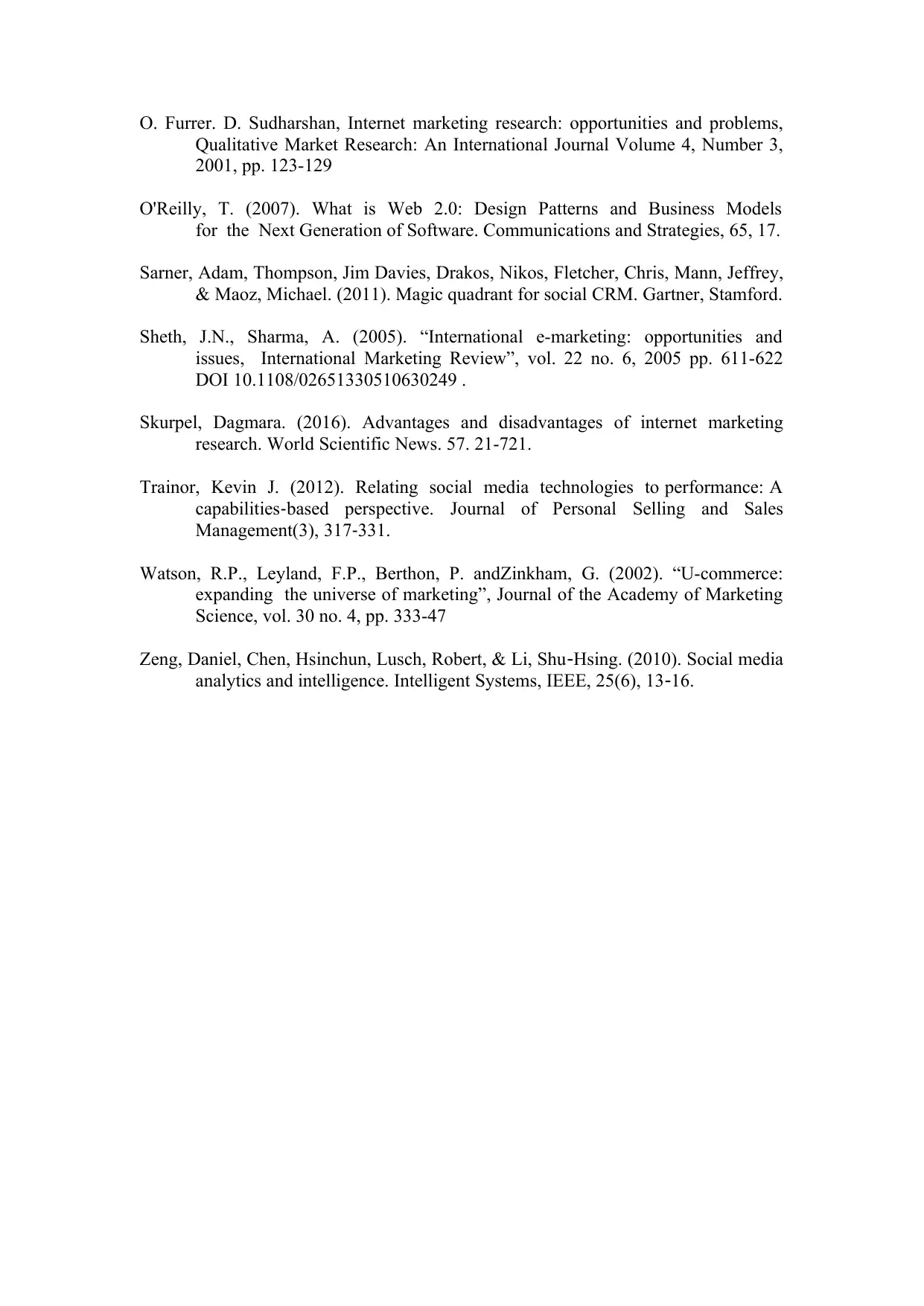
O. Furrer. D. Sudharshan, Internet marketing research: opportunities and problems,
Qualitative Market Research: An International Journal Volume 4, Number 3,
2001, pp. 123-129
O'Reilly, T. (2007). What is Web 2.0: Design Patterns and Business Models
for the Next Generation of Software. Communications and Strategies, 65, 17.
Sarner, Adam, Thompson, Jim Davies, Drakos, Nikos, Fletcher, Chris, Mann, Jeffrey,
& Maoz, Michael. (2011). Magic quadrant for social CRM. Gartner, Stamford.
Sheth, J.N., Sharma, A. (2005). “International e-marketing: opportunities and
issues, International Marketing Review”, vol. 22 no. 6, 2005 pp. 611-622
DOI 10.1108/02651330510630249 .
Skurpel, Dagmara. (2016). Advantages and disadvantages of internet marketing
research. World Scientific News. 57. 21-721.
Trainor, Kevin J. (2012). Relating social media technologies to performance: A
capabilities‐based perspective. Journal of Personal Selling and Sales
Management(3), 317‐331.
Watson, R.P., Leyland, F.P., Berthon, P. andZinkham, G. (2002). “U-commerce:
expanding the universe of marketing”, Journal of the Academy of Marketing
Science, vol. 30 no. 4, pp. 333-47
Zeng, Daniel, Chen, Hsinchun, Lusch, Robert, & Li, Shu‐Hsing. (2010). Social media
analytics and intelligence. Intelligent Systems, IEEE, 25(6), 13‐16.
Qualitative Market Research: An International Journal Volume 4, Number 3,
2001, pp. 123-129
O'Reilly, T. (2007). What is Web 2.0: Design Patterns and Business Models
for the Next Generation of Software. Communications and Strategies, 65, 17.
Sarner, Adam, Thompson, Jim Davies, Drakos, Nikos, Fletcher, Chris, Mann, Jeffrey,
& Maoz, Michael. (2011). Magic quadrant for social CRM. Gartner, Stamford.
Sheth, J.N., Sharma, A. (2005). “International e-marketing: opportunities and
issues, International Marketing Review”, vol. 22 no. 6, 2005 pp. 611-622
DOI 10.1108/02651330510630249 .
Skurpel, Dagmara. (2016). Advantages and disadvantages of internet marketing
research. World Scientific News. 57. 21-721.
Trainor, Kevin J. (2012). Relating social media technologies to performance: A
capabilities‐based perspective. Journal of Personal Selling and Sales
Management(3), 317‐331.
Watson, R.P., Leyland, F.P., Berthon, P. andZinkham, G. (2002). “U-commerce:
expanding the universe of marketing”, Journal of the Academy of Marketing
Science, vol. 30 no. 4, pp. 333-47
Zeng, Daniel, Chen, Hsinchun, Lusch, Robert, & Li, Shu‐Hsing. (2010). Social media
analytics and intelligence. Intelligent Systems, IEEE, 25(6), 13‐16.
⊘ This is a preview!⊘
Do you want full access?
Subscribe today to unlock all pages.

Trusted by 1+ million students worldwide
1 out of 9
Related Documents
Your All-in-One AI-Powered Toolkit for Academic Success.
+13062052269
info@desklib.com
Available 24*7 on WhatsApp / Email
![[object Object]](/_next/static/media/star-bottom.7253800d.svg)
Unlock your academic potential
Copyright © 2020–2025 A2Z Services. All Rights Reserved. Developed and managed by ZUCOL.




